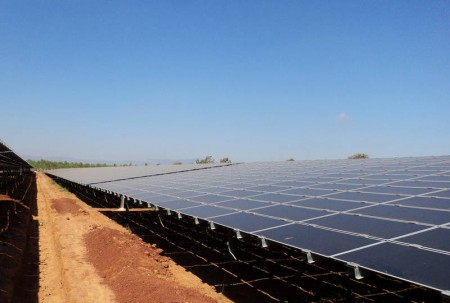By Vignesh Gowrishankar and Sameer Kwatra, Natural Resources Defense Council
Earlier this month, over 150 solar companies bid for the “second batch” of projects allotted under Phase 1 of India’s National Solar Mission. This sustained and arguably growing interest in the solar energy program is largely attributed to the Indian government’s modifications to the Solar Mission Guidelines. NRDC and our partner, Council on Energy, Environment and Water (CEEW), have been discussing perspectives on the Solar Mission with key solar energy stakeholders, including the government, the industry and the industry observers over the past month. We are learning about progress towards installing 20,000 megawatts (MW) of solar generation by 2022 under the Mission, as part of our independent assessment of the Solar Mission.
We are now in the latter half of Phase 1 of the Solar Mission, which aims to install 1,000 MW by 2013. The “first batch” of bids under Phase 1 was for 620 MW – 150 MW for solar photovoltaic and 470 MW for solar thermal. The Indian government also moved existing solar projects to count towards the Solar Mission, providing an additional 30 MW of capacity. The second and current batch of bids is for the remaining 350 MW under Phase 1.

So what happened earlier this month? Over 150 companies applied for the available allotment, with a total of 218 proposals, all for solar photovoltaic projects. The total capacity of solar projects in the proposals was over 2,500 MW, seven times the allotment available. This in itself is impressive, and parallels the level of interest seen after the first batch under Phase 1.
Another encouraging development is the mix of companies applying. An increasing number of large and established companies such as Reliance Power and Tata Power are among the current applicants. Also in the fray are international applicants Gestamp Solar of Spain and Fonroche Energy of France. This is in addition to solar power units of Lanco Infratech, Moser Baer, Infrastructure Leasing & Financial Services and Mahindra Solar One from the private sector, and GAIL (India) and Hindustan Petroleum from the public sector. US thin film photovoltaic manufacturer First Solar already has projects in the Indian states of Gujarat and Andhra Pradesh.
Some companies avoided bidding for the first batch allotment of 620 MW, citing unfavorable terms and small project size, which make achieving economies of scale difficult. In response, for the second batch, India’s Ministry of New and Renewable Energy has responded by making the terms more attractive and extending the timelines. The changes included:
- Increasing the maximum size of the projects to 20 MW and allowing firms to bid for a maximum of three projects having a total capacity of 50 MW. For the first batch, firms were only allowed to apply for one project with a maximum capacity of 5 MW.
- Extending the timeline to achieve financial closure to 210 days from the time of signing power purchase agreements, up from 180 days for the first batch. The timeline for project commissioning was similarly increased by one month to 13 months from the time of signing.
These changes have at least had the intended effect of attracting established companies with sizeable financial resources and technical expertise to participate in the Solar Mission. Whether they are eventually selected remains to be seen. But if they are, we cautiously hope that higher-quality projects can be implemented at a faster pace. These projects are to become operational by early 2013.
In the next few months, we look forward to assessing the projects that do come online. Solar photovoltaic projects from the first batch will be commissioned by January 2012 (solar thermal projects by early 2013).
We also look forward to analyzing how the bidding process for the second batch plays out. The next steps for NTPC Vidyut Vyapar Nigam (NVVN), which is the central coordinating agency, are to:
- Complete a technical evaluation of the bids in the coming weeks;
- Shortlist companies to seek price bids by mid November; and
- Select companies and sign agreements with selected companies by January-February 2012.
Installing 350 MW of solar is expected to cost about 35 billion rupees (3500 crore rupees or about $715 million). That’s a considerable investment, but also a promising business opportunity. In that context, and compounded by more favorable terms, a stronger applicant pool and dropping module prices, India could see some aggressive price bids.
Keep an eye out for future blogs here as the process unravels.
![]() Editor’s Note: This column comes to us as a cross post courtesy of Natural Resources Defense Council. Author credit for this column goes to Vignesh Gowrishankar and Sameer Kwatra.
Editor’s Note: This column comes to us as a cross post courtesy of Natural Resources Defense Council. Author credit for this column goes to Vignesh Gowrishankar and Sameer Kwatra.